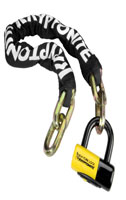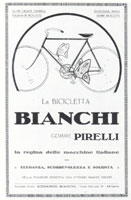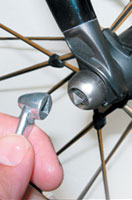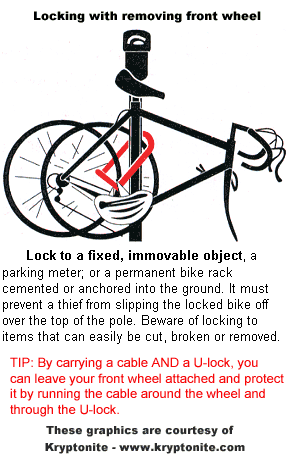
Note that I wrote this article for the Santa Cruz County Cycling Club, so it refers to locations in Santa Cruz, California where I live. To learn safe and dangerous locations in your town, and which are the best locks for your bicycle and how you use it, please discuss how to lock and where to lock your bicycle with your favorite bicycle dealer or fellow cyclists.

The Kryptonite New York Fahgettaboudit: heavy, expensive, and worth it.
I’ve owned approximately fifty bicycles, but I’ve been lucky enough to only have one stolen. It happened in 1990 in Italy while on a ten-day tour of Italian bicycle factories sponsored by the Italian Bicycle and Motorcycle Trade Association. On the first day, we stopped near Lake Como for lunch and while we were eating, thieves broke open the van and stole my ride, a nice Specialized Allez I’d customized with hydraulic brakes and super-light pedals.
Our hosts were as dismayed as we were, but there wasn’t a thing they, or the carbinieri (police) could do. So we returned to the hotel in Milan, and I spent the evening bummed that I probably wasn’t going to be able to pedal through the incredible Italian countryside. I needn’t have worried.
Bianchi blows me away

The first visit in the morning was to Bianchi, one of the oldest bicycle manufacturers (click to view the vintage Bianchi ad, right), and located in a sprawling multi-building complex. We entered via the company’s well-stocked retail store, which had Bianchi everything, from socks and shoes to bottles, toe straps, pumps, hats, bags, wheel covers — you name it.
Before we could reach for our wallets, however, we were introduced
to a tall, handsome, well-dressed and very fit-looking gentleman, who I recognized
as Felice
Gimondi, one of the greatest roadies ever and a celebrity in Italy.
He greeted us in Italian (while the interpreter translated) and then looked
directly at me and apologized for my bicycle being stolen. He then explained
that by the end of our factory tour, he’d have a new Bianchi ready for
me to take back to America, which he did. And I rode that Celeste full-Campy
beauty out to Monza and back the next day in my new Bianchi socks and shorts.
Bicycle theft is bad news
Unfortunately, most stolen bicycle stories don’t have such happy endings. And while I’ll never forget receiving that new Bianchi, I’ll also always remember and miss my stolen Allez. It had special meaning, too, as all bicycles have to their owners.
That’s the saddest thing about bicycle theft. You get attached to your bike and when it’s stolen, you feel violated, lost, depressed. In fact, plenty of people have given up bicycling because their bicycles got stolen, which made them feel violated, unsafe and at risk. Rather than suffer these feelings again, they take up other activities that seem safer.
It’s sad, too, that kids are afraid to ride to school for fear that their bike won’t be there when they get out. And that a lot of people who might consider biking around don’t do so, because they feel like there’s no way to keep their bicycle safe while they’re in a store or restaurant. Hopefully, the tips in this article will help you learn how to lock your bicycle and keep it safe and sound.
Recognize the risks
There are two main points every cyclist should keep in mind. The first is to recognize that there are thieves out there and that they know how to steal bicycles, even locked ones. So you’ve got to be alert and careful; a lot more about this in a minute.
The other key point that’s rarely explained is that when a bicycle is stolen, it’s not a hopeless situation. While it may be unlikely that you’ll see your baby again, if you act fast and do the right things, there’s a reasonable chance of recovery. Bike Index is an easy and free way to register your bike and increase the chances of finding it if it’s stolen (click below).
How to keep your bicycle yours
Believe it or not, the vast majority of stolen bicycles get that way because they weren’t locked. So, your first defense against theft is purchasing a quality lock and using it whenever you leave your ride unattended. The safety of your cycle is very important. You can check an interesting article on bike locks and their features. Thieves actually usually ignore protected two wheelers because so many freebies are readily available.
But don’t just slap on the lock any old which way. Bike thieves are the lowest of the low, but they’re not always stupid. They’ll get your machine or part of it, if you’re lazy about securing it. For example, most bicycles are equipped with easily removed wheels, which make it cake for crooks to swipe a very expensive chunk of your machine if you forget to lock the wheels (or the rest of the bicycle, if you only secure one wheel!).
Likewise, if you wrap a cable around a parking meter, thieves can just lift the bicycle over the post’s top, toss your pride and joy in their truck/trunk and take it home where they can break off the lock at their leisure.
Speaking of parking meters, my favorite bike theft story involves the cyclist catching the thief in the act of taking his bicycle. Enraged, he knocks the bum down, unlocks his U-lock and then slides it around the creep’s neck and locks him to the parking meter! Even if it’s only an urban legend, it’s a sweet story to anyone who has had a bike stolen.
Here are some rules on how to lock and safeguard your bicycle:
7 super safety rules and two alternative suggestions
- Ask other cyclists and bike shop personnel where the high-risk areas in town are, so you won’t make the mistake of parking your bike there.
- At home, store your bicycles inside. If kept in a garage, leave the door closed and store the two wheelers out of sight (consider locking them, too); because you never know who might cruise your neighborhood looking for valuables. Here are my tips on securing your garage to keep thieves out in my Jim's Tech Talk column on RoadBikeRider.
- When stopped, if you can’t take your bicycle inside, always use your lock. If you don’t have a lock and you have to go inside without your bicycle, park it near the window so you can see it. But also make it impossible to ride by removing the front wheel and bringing that in with you. Or, keep a strong elastic (rubber band) wrapped around your handlebar and pull it out and over your brake lever to lock on your front brake. Or, if you have a derailleur drivetrain, lift the chain off the chainring. Or run your helmet strap through the rear wheel and frame and buckle it. If a thief tries to grab your disabled bike, hop on, and ride it, he’ll crash and you can grab your bike.
- Always lock your bicycle in a safe area and to an unbreakable and immovable object being certain to secure the frame and both wheels (see the illustration below). If you must park in a high risk area, use two good locks, and different types, such as a U-lock (called a D-lock in some countries) and a quality chain-type lock like Kryptonite's impenetrable Fahgettaboudit lock shown at the top of this page, or their New York Chain lock. This arrangement thwarts thieves prepared to only attack U-locks. See the diagrams below for instructions on locking with and without front wheel removal.
 Take
with you any easily-removed accessories and components such as pumps, cyclecomputers,
lights, seat bags, quick-release seat and seatpost, etc. You can also purchase
locking quick releases to safeguard your wheels, such as Delta Cycle’s
Hublox Security Skewers
which require a unique key that only comes with the skewers. Another company
that makes wheel and components locks like this is Pinhead. This Pinhead
Bicycle Locking Skewer Set includes locks for the wheels and seatpost
(so thieves cannot steal your seat and post simply by loosening one bolt).
Take
with you any easily-removed accessories and components such as pumps, cyclecomputers,
lights, seat bags, quick-release seat and seatpost, etc. You can also purchase
locking quick releases to safeguard your wheels, such as Delta Cycle’s
Hublox Security Skewers
which require a unique key that only comes with the skewers. Another company
that makes wheel and components locks like this is Pinhead. This Pinhead
Bicycle Locking Skewer Set includes locks for the wheels and seatpost
(so thieves cannot steal your seat and post simply by loosening one bolt).- To reduce the risk of becoming a target, never tempt thieves by leaving your bicycle locked for long periods such as overnight, or securing it in a predictable fashion, such as putting it in the same bicycle rack every day.
- Mark your bicycle so that you can easily prove it’s yours. Some fire station or police departments sell bicycle licenses, which is one way to label your bicycle. There are links above on this page that take you to online registries. You can also simply write your name on a piece of paper and slip it inside the handlebars. Or write your name underneath your seat with an indelible marker — a trick that allowed my friend to recover his stolen Peugeot when he found it years later at a yard sale!
- If you’re convinced no lock can keep your bicycle safe and you mainly bicycle around town, buy a Brompton. This ingenious folding bicycle collapses without tools in about ten seconds to such a small size that you can put it in a Safeway cart with room to spare for groceries. Because it folds so small and so quickly, you never have to leave it outside. Just bring it in with you. It’s a nice riding bicycle, too, with impressive features. If you don’t want such a deluxe folding bicycle, there are plenty of more affordable options, like Dahon folding bikes.
- Some people choose to ride a junker of a bike so rusty and trashed that nobody would bother to steal it. Some even mess up the bike even more with stickers, duct tape, patches of ugly paint—you get the idea. Keep in mind, though, that even these get stolen sometimes. But at least you won’t lose an expensive treasure you care about.

Getting a stolen bicycle back
I know it seems hopeless when your bicycle is ripped off. But maybe it will steel your resolve to hear that I know two cyclists who had their bicycles stolen in New York City and later recovered them. One guy found his in a yard sale two years after he lost it (the guy who wrote his name on the bottom of his seat). The other guy walked door-to-door for weeks, passing out fliers and talking to people, until he got a lead and recovered his Raleigh.
In both cases, the bicycles were found in the same condition they were in before they were stolen. I can tell you plenty of stories like this about bicycles that were stolen in Santa Cruz, too—some from readers using the tips in this article.
People claim that bicycles are stolen in bulk and taken out of the area to be sold. Or, you hear that there are rings of thieves who steal bicycles and strip all the parts and make money selling the parted-out machines or refurbished bicycles built of the parts. That may go on. But in my experience, it’s very rare.
Where they go
Once stolen, bicycles are usually sold ASAP to someone for quick
drug money. Or the bicycle remains with the person who stole it, or with that
person’s family, or the general community where he/she lives. Even when
the bicycle is turned for drug money, if the transaction takes place here,
the bicycle will probably stay here. Lots of stolen bicycles end up on CraigsList.org
so it's a good idea to check there for yours, too. Or maybe seek the services
of a Bicycle
Batman superhero for help.
So how do you get your stolen bike back? The most important thing is to act
fast once a bicycle is stolen. If you wait, you might forget details about
the bicycle that help identify it. And, you’ll miss the chance of letting
people know about your bicycle during the time when it’s most likely
to be found.
Often, a thief will try to get the bicycle repaired (bicycles that ride are easier to sell), and if you’ve alerted the shops, the mechanic will recognize the bicycle and call you. Also, thieves often try to sell bicycles to shops, which never works because the crooks have no idea what the bicycle is worth. When they ask for way-too-low a price, it always raises suspicions and the shops call the cops.
Steps to take to get your bicycle back
- Print hundreds of fliers with a short, accurate description of your stolen bicycle and put them everywhere. As the weather ruins the fliers and knocks them down, put up more.
- Hand-deliver a flier to every bicycle shop in town. They may ask you to write down the information on a card (because it takes less space) and place it on their bulletin board. The important thing is that you let them know the details, so they can ID the bicycle if it comes in.
- Tell everyone you know that the bicycle was stolen and offer to give them a flier. Spread the news to your friends on Twitter, Facebook, etc.
- Aggressively search for your bicycle by checking everyplace you think it might turn up. Keep in mind that most of the time, the bicycle is still being ridden, so there’s a pretty good chance it might turn up where you see lots of bicycles, such as on Pacific Avenue in Santa Cruz, or along West Cliff Drive. Check CraigsList online ads too.
- Use your best judgment if you happen to spot your bicycle. I know it seems risky, but most recoveries happen because the owner simply grabs the bicycle when he sees it or stops and confronts the person riding it. These people usually know that something’s fishy with the bicycle they’re riding, and they’re usually ready to give it up rather than deal with a trip to the police station to discuss things. Obviously, I’m not recommending you take unnecessary risks. But if you see your bicycle, it may well be your only chance to get it back. If you call the police, the bicycle may be long gone before they ever show up.
- If you find your stolen bicycle and it’s parked, you can take it. But, if the thief has locked it with his lock, a recovery technique that works is to lock the bike with your lock (a second and different lock). As soon as you’ve locked it, call the police and tell them you’ve found your stolen bike and need them to arrest the thief when he returns. It might turn out that the person with your stolen bike bought it from the thief. But, it’s still your bicycle and the police will give it to you as long as you can prove it’s yours and was stolen.
- Don’t give up looking for your bike. Sometimes it takes quite a while for a stolen bicycle to surface. Be patient and tenacious in your searching, and you just might be rewarded as my 14-year-old daughter was. It took her two years, but she kept looking, and one day got her bicycle back by asking for it from the boy she saw riding it.
Why I left out the how of bicycle theft
You’ll notice that I didn’t describe the details of how thieves steal bicycles. While I’d enjoy busting some myths (no, thieves don’t commonly break locks with liquid nitrogen) with a complete explanation right down to what tools they use and how they behave, I’d rather not give them any help.
So for now, if you’re interested in the details, ask me the next time you see me on a ride. In the meantime, keep your bicycle safe. And, perhaps bicycle manufacturers will someday insert GPS tracking devices on every new bike—wouldn't that be nice?
